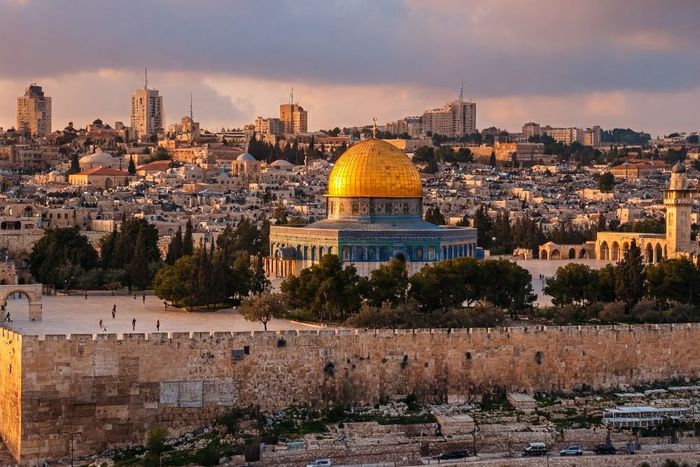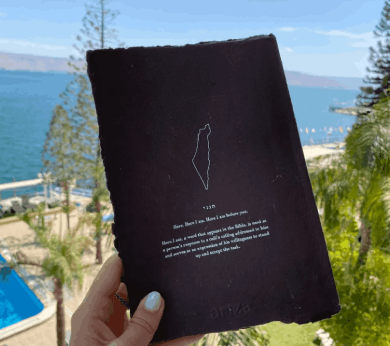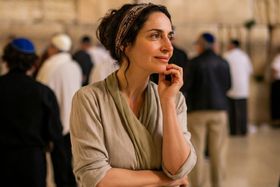10 Interesting Facts About Jerusalem: A City of History & Wonder
Jerusalem, a city that has been conquered over 40 times, holds some of the world's most fascinating secrets. We bring to you 10 interesting facts you may have not known until now.
Updated January 22, 2025.

Jerusalem, a city etched in stone and scripture, whispers secrets that span millennia. Beyond the well-trod paths of pilgrimage and the headlines of geopolitical strife lies a trove of captivating details.
From ancient tunnels hidden beneath the Old City to a surprisingly diverse culinary scene, this city has a rich, layered history. This is a Jerusalem you may not know, a city of wonder waiting to be rediscovered.
» Decorate your walls with a Jerusalem Psalm Tapestry
Understanding Jerusalem
Jerusalem is a city steeped in history and religious importance. It was founded around 3000 BCE and is located in the Judean Hills. Its unique geography and strategic location have shaped its destiny for over 5,000 years.
The city's location has always been important. High up in the hills, it was easy to defend. The Gihon Spring provided water, and its location between continents made it a hub for trade.
Jerusalem has a long and tumultuous history and has been conquered many times. It's difficult to give an exact number, as there are different interpretations of what constitutes a "conquest." Some sources say Jerusalem has been captured 44 times, while others put the number higher.
A Sacred City for Many
While Jerusalem's earliest settlers remain unknown, its development spans millennia, beginning around 3000 BCE. Canaanites fortified the early city, and King David made it the capital of Israel around 1000 BCE.
His son Solomon built the First Temple, further establishing its religious importance. Countless empires, from Babylonians and Romans to Muslims and Crusaders, have since conquered and rebuilt Jerusalem, each leaving its imprint on this ancient and contested city.
The city is very for Christians. It's where many events in Jesus' life happened, like his crucifixion and resurrection. The Church of the Holy Sepulchre, where Jesus' tomb is believed to be, is a major pilgrimage site.
10 Facts You Should Know About Jerusalem
1. Roman Theatre in Western Wall Tunnels
Jerusalem is famous for its religious sites, like the Western Wall and the Old City. But hidden beneath the surface lies a surprise: a 1,700-year-old Roman theater! This discovery shows us that Jerusalem wasn't just a holy city; it was also a bustling Roman center with public entertainment.
This theater highlights the many different cultures that have influenced Jerusalem. Its 200-seat structure reminds visitors of the Roman Empire's impact on the city.
Researchers found the theater by chance while exploring Wilson's Arch, an ancient bridge. Interestingly, the theater was never finished. Why? Perhaps because of political problems or money troubles.
This "unfinished masterpiece" is buried underground, offering a glimpse of a Roman Jerusalem we rarely imagine.
Explore Our Collection of Handcrafted Items from Jerusalem
2. Significance of Jerusalem's Gates
Jerusalem's 11 gates are not just beautiful—they were smartly designed to protect the city. Their angled entrances forced attackers to slow down, making it hard to charge in.
Defenders could even pour boiling liquids on enemies through holes in the gates! These gates symbolize Jerusalem's strength. They've witnessed many battles and shown the city's importance throughout history.
The Jaffa Gate is a main entrance and a cultural symbol. Its Arabic name, Bab el-Halil, means "The Beloved" and honors Abraham, an important figure in Judaism, Christianity, and Islam.
Another gate, the Zion Gate, still has bullet holes from the 1948 Arab-Israeli War. It's a reminder of the conflicts Jerusalem has faced.
» Check out our list of the best gifts to bring home from Jerusalem
3. Golden Gate's Dual Meanings
The Golden Gate is a sealed gate on the eastern wall of the Temple Mount. It's more than just a closed door, though. It symbolizes hope and prophecy for both Jews and Christians.
Jews believe the Messiah will enter Jerusalem through this gate. Christians connect it to when Jesus entered the city. Suleiman the Magnificent sealed the entrance in the 16th century to stop the Messiah, which is an interesting part of its story.
Suleiman also sealed the gate to show Islamic power in Jerusalem. He even put a Muslim cemetery in front of it to stop the Messiah, who was thought to be a Jewish priest (priests can't touch graves).
But even with the gate closed, Jews and Christians still believe it will be important in the future. This makes the gate seem mysterious and special.
» Learn more about the sacred sites Jesus has visited
4. Jerusalem’s Role in Early Cartography
Many people know Jerusalem is a holy city, but did you know it was once considered the center of the world? Old maps from the 13th century, like the Hereford Mappa Mundi, actually put it right in the middle! This shows how important the city was to people's faith.
The Hereford Mappa Mundi is a really cool map that shows us how people saw the world back then. It was made around 1300, and it shows Jerusalem with a domed building at its center, surrounded by places from the Bible, myths, and real life.
» Make a list of the must-see sights while you are in Jerusalem
5. Crusader Graffiti
We often think of Crusaders as warriors, but they were also people of faith. Inside the Church of the Holy Sepulchre, they left graffiti—crosses and messages carved into the walls. These markings show their devotion.
The graffiti reminds us that Jerusalem has always been a holy city. For centuries, people have felt connected to God there.
Many Crusaders traveled to Jerusalem to ask for forgiveness. They left graffiti to show their religious commitment. Some carvings might even be family symbols. Today, experts study them to learn more about the Crusaders.
6. A Crusader-Era Winepress Found in the Old City
A 12th-century winepress was found in Jerusalem, showing us a different side of the Crusaders. They weren't just fighters; they also made wine! It's cool to see how they brought their traditions to the city.
This discovery reminds us that Jerusalem has always been a mix of different cultures. It's not just a place of conflict; it's where people from all over have made their mark.
The Crusaders didn't just fight in Jerusalem. They also tried to build a life there. Winemaking has a long history in the city, going back to biblical times. Wine was a big part of Jewish and Christian traditions.
» Explore part one of our three-part series about Israel's Christian churches
7. Jerusalem’s Unique Climate
Many people think Jerusalem is always hot and dry, but its weather can be surprising! The summers are scorching, but it sometimes snows in the winter. This creates an environment where all kinds of plants can grow, from olive trees to rare orchids.
Jerusalem is a city of contrasts, with a rich history and a vibrant present. Like the tough olive trees that grow there, the city and its people are strong. Some of those trees are over 800 years old!
When it snows in Jerusalem, people celebrate. It's amazing to see holy sites covered in white. Olive trees are also special because they connect to the Bible. Some may have even been around when Jesus prayed in the Garden of Gethsemane.
» Read or month-by-month breakdown of the best times to visit Israel
8. Jerusalem’s Unique Sundials
You know how sundials tell time? Well, the ones found in Jerusalem were special. They were made to show the times for Jewish prayers. This shows us how important faith was in everyday life back then. Finding one on the Mount of Olives, a sacred spot, makes it even more special.
These sundials show how connected faith and daily life were in Jerusalem. People were devoted to their beliefs and used technology to help them practice their religion.
The Mount of Olives is an important place for prayer. The sundial found there was designed to match Jewish prayer times. This tells us that people in Jerusalem wanted to honor their faith all the time. They probably used sundials to make sure they prayed at the right times.
» Find out what it takes to hike the Israel National Trail
9. The Ethiopian Church Has Its Rooftop Village
Most visitors miss the secret village on the roof of the Church of the Holy Sepulchre! Ethiopian monks live there, with their homes and places to pray. It shows how diverse Jerusalem is and how even rooftops can become holy.
This village shows how Jerusalem welcomes all kinds of faiths. Different religious groups live together and find places to practice their beliefs, even in unexpected spots.
The Ethiopian monks have a long history in Jerusalem. Their rooftop monastery has been a point of disagreement between different Christian groups, but the monks remain.
You might see them in their traditional robes, praying or caring for their home. Their life on the roof shows the strength of faith in busy Jerusalem.
10. Jerusalem’s Armenian Pottery Tradition
Jerusalem has a beautiful tradition of Armenian pottery. It started in the early 1900s when Armenian artists mixed their style with Middle Eastern designs. You'll often see colorful flowers and Bible scenes on these pieces.
This pottery shows how different cultures come together in Jerusalem. The city loves art and history!
Armenian artists were invited to fix the tiles on the Dome of the Rock. Their work was so impressive they opened workshops in the Old City. Today, families like the Karakashians and Sandrounis are still making this pottery, often with pictures of Jerusalem and religious symbols.
» Understand the significance of Israel's Negev desert
Learning from Jerusalem: Lessons in Resilience
Jerusalem is an amazing city that has survived for thousands of years! It welcomes people of all backgrounds and protects its history while growing with the times. Modern cities can learn a lot from Jerusalem!
Many groups work to protect Jerusalem's heritage. The Israel Antiquities Authority manages important archaeological sites. The government also helps restore landmarks and encourages tourism.
Organizations like the Jerusalem Foundation work with locals to teach people about history and protect old neighborhoods. International groups like UNESCO also help preserve the Old City.
You can help, too! Donate to organizations, volunteer, or support local artists. Spread the word on social media to help protect Jerusalem's history and culture.
» Discover the best wineries in Israel an learn more about them
More Than a Holy City
These glimpses into Jerusalem's hidden depths are merely a starting point. The city beckons the curious traveler and the armchair historian alike to delve deeper, to uncover more of its secrets, and to experience firsthand the vibrant tapestry of its past and present.
Jerusalem's story is far from finished; it is a narrative waiting to be explored, understood, and ultimately, written anew by each visitor who dares to look beyond the surface. And if you yearn to carry a piece of this ancient city home, to weave its threads into their narratives, there's Artza.
This online store offers a curated collection of authentic Jerusalem souvenirs—handcrafted treasures that capture the city's essence. Discover exquisite jewelry reflecting the city's artistry, traditional ceramics, and fragrant spices that evoke the aromas of its bustling markets.










